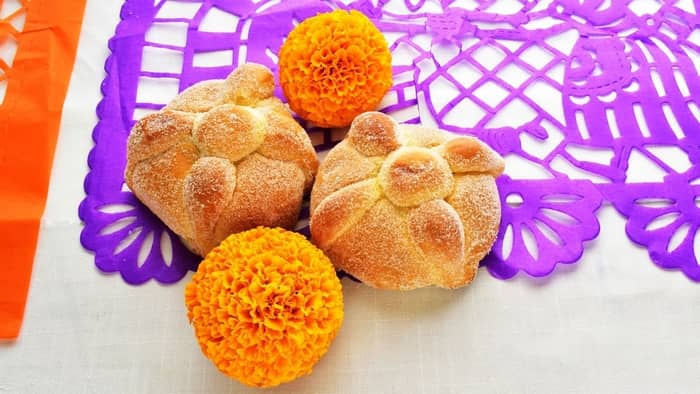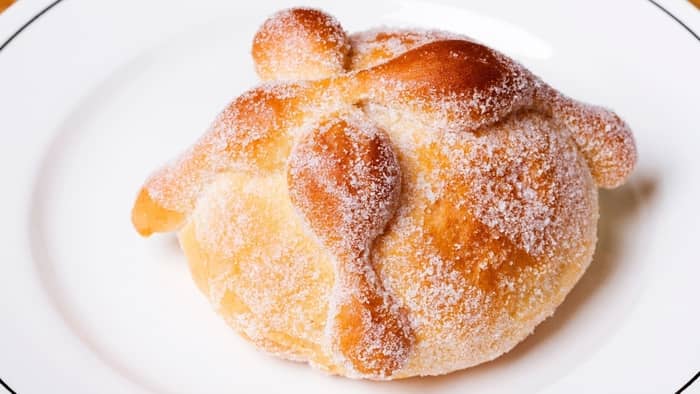Last Updated on October 25, 2021 by Guillermina
You may have wondered about the pan de muertos history, especially when you consider its intriguing name.
Pan de muertos, or the bread of the dead, is a real treasure of Mexican baking. It is something that all families wait all year long to enjoy once again alongside a warm cup of hot chocolate. This treat allows people to take some time to reflect on the more positive aspects of life. As this bread is so sweet, it really does warm the soul on a brisk autumn evening. The ornate presentation perfectly reflects this pan de muertos feature, especially when it is prepared by a specialty bakery.
It’s quite common for families to place an order at bakeries. Customers know the best bakeries for producing not only delicious pan de muertos, but also a version that’s beautifully shaped with specific themes. It should then come little surprise that many bakeries do see this as an opportunity to get quite competitive. Some even classify their creations as gourmet.
Table of Contents
What Is Pan De Muerto?
Pan de Muerto is a sweet bread that is made up of wheat flour, milk, eggs, yeast, and butter. Some people add oranges such as orange blossom water or orange zest. Pan de Muertos have a circular shape and it comes in different sizes. It all depends on how many people will be sharing the bread. It is decorated with elongated pieces of mass repressing the bones. Once you complete baking it, you can add sugar or cinnamon. It is a good idea to sprinkle ajonjolí seeds on the top. Some people tint the sugar with red to resemble blood.

Some researchers believe that its circular shape represents the cycle of life and death. For them, it is quite evident that the pieces of mass placed on top represent not only the bones but also the human scalp. Other researchers see the placement of these stripes of mass as an indication of the four cardinal points of the universe. This is also perceived as a celebration of the Mexicans gods: Tláloc, Tezcatlipoca, Xipetopec and Quetzalcoatl.
However, some people consider that the placement of the elongated mass represents a flower with its petals. Thus, this bread works a creative adornment to the private altars and public shrines for the people who have passed away.
Another beauty of this baked treat is that it comes in so many different flavors. Many people maintain that orange is the best flavor, with good reason. However, there are more and more newer flavors being made available all the time. For this reason, many families will buy different flavors which children love to compare. Kids love treating themselves and dipping their slices of pan de muerto in their cup of hot chocolate. They will enjoy it differently if it is orange, lemon, or vanilla-based!
Learn more about How To Make Horchata Without Rice Is Easy
Why Is Pan De Muerto Important?
Pan de muertos carries a lot of meaning with it. It serves as an opportunity to relate with our ancestors in the company of family. The dead bread can have many different kinds of shapes with meanings that are related to the dead people that families are celebrating. The origins of this bread has been up for discussion for many years. The idea that they were most likely used for certain ceremonies is not overly questioned.
However, many researchers find its origin in Spain, especially, in the so-called bread with enriched mass. This bread has its origin in the Middle Ages when churchgoers prepared sweet bread to celebrate de Day of the Dead.
Other researchers believe that pan de muertos represented the positive wishes for women who had died giving birth. Also, the pan de muertos is related to the huitlatamali, a kind of tamal that was prepared to honor the deceased people.
Whatever the case may be, it would take the shape of different positive symbols and creatures like butterflies. It’s interesting to think about what, hundreds of years in the past, this bread might have looked like. This is especially true when you consider that they were made with corn. As you can imagine, corn was considerably much harder to shape when the intention was for it to be baked.
Intriguing Facts About Pan De Muerto Mexico
The tradition for many on the day of the dead is to visit the resting place of relatives and to set up offerings so that they may come visit us. Pan de muertos is one such invitations. Alongside candles, the place looks like a very pretty scene. People even eat big meals on the tombs of their loved ones and, of course, share pan de muertos.
Also, people set up shrines in their homes to honor the relatives and loved ones who have passed away. These kinds of shrines are very personal affairs, and photos and objects that relate to the deceased are set up to make them feel welcome. Family members are very careful to select treats that the deceased ones loved such as alcoholic beverages including tequila or mezcal, mole con pollo, fruit. This ornaments are left on the altar throughout the Day of the Dead season which can be one week long.
Read more about An Intriguing Question: Where Did Quesadillas Originate?

Conclusion
If you already have a lot of love for Mexican culture in general, you can take up the opportunity to explore it through this wonderful tradition. Pan de muertos varies from state to state. It’s quite interesting to see how the gastronomy and culture of these diverse places illustrate the richness that indigenous peoples carry down from generation to generation.
It is estimated that there are around 400 different types that are prepared. This gives you an idea of how personal and festive of an expression it has grown to be. Baking artisans have really pushed their creativity. You can check this out by searching for pictures online that illustrate all manner of sizes and ingredients. This speaks to the cultural strength and diversity that draws people every day to Mexico’s culinary uniqueness.

Maria is a passionate Mexican–American cook who loves to create delicious and authentic Mexican cuisine. She has been cooking since she was a young girl, learning traditional recipes from her grandmother. She loves to experiment with new flavors and to use local, seasonal ingredients whenever possible. She enjoys introducing her guests to the flavors of her culture and sharing stories of the history of Mexican cuisine. Maria takes great pride in her cooking and loves to see how her food brings people together. She is always looking for ways to make her dishes even more delicious and inviting.
